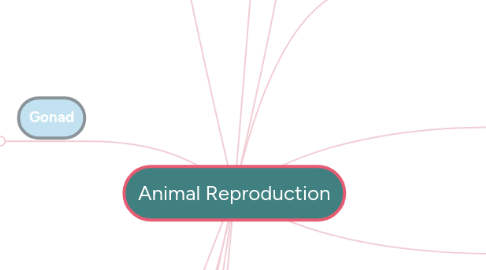
1. 3. When an animal ovulates, it comes into oestrus (in heat)
2. Male reproductive system
2.1. Sperm duct
2.1.1. Carries sperm from the testes to urethra
2.2. Penis
2.2.1. Places sperm inside the vagina
2.3. Testis
2.3.1. Produces testosterone, sperm matures and is stored here
2.4. Prostate gland
2.5. Scrotum
2.5.1. Testes at lower temperature (35 Degrees Celsius) i.e. optimum temperature for meiosis
2.6. Bladder
2.7. Seminal vesicle
2.8. Cowper’s gland
2.8.1. Produces seminal fluid which nourish sperm and allows them to swim. Sperm + fluid = semen
2.9. Urethra
2.10. Epididymis
2.10.1. Matures and stores sperm
2.11. Vas deferens
2.11.1. Stores sperm
3. Female reproductive system
3.1. Ovary
3.1.1. Produces eggs and and female hormones oestrogen and progesterone
3.1.2. Oestrogen causes egg production and ovulation
3.1.3. Progesterone can prevent ovulation(sponging) and maintain pregnancy
3.2. Fallopian tube
3.2.1. Site of fertilisation
3.2.2. Catches eggs released from ovary and transports it to uterus
3.3. Uterus
3.3.1. Site of implantation
3.3.2. Lining (endometrium) enriched with blood vessels to hold and nourish embryo.
3.4. Cervix
3.4.1. Neck of uterus
3.4.2. Allows sperm to enter
3.4.3. Dilated during labour
3.5. Vagina
3.5.1. Allows entry of spent and exit of foetus during labour
4. Gonad
4.1. Is an organ that produces gametes in animals
4.2. Male = testes
4.3. Female= ovaries
5. Male hormones
5.1. FSH
5.1.1. Follicle stimulating hormone
5.1.1.1. Sperm production
5.2. LH
5.2.1. Luteinising hormone
5.2.1.1. Stimulates testosterone production
5.2.1.2. 7. The vagina, which holds the penis during copulation, serves as a birth canal.
5.3. Testosterone
5.3.1. Plays a role in the development of the testes and prostate gland
5.3.1.1. Responsible for the male sex characteristics as well as increasing the muscle and bone growth
6. Female hormones
6.1. FSH
6.1.1. Encourage the growth of a follicle in the ovary
6.1.1.1. Pituitary gland
6.1.1.1.1. Follicle produces oestrogen
6.2. Oestrogen
6.2.1. Stimulate growth of endometrium in the first half of the oestrous cycle
6.2.2. Promotes secondary sex characteristics in the female i.e. growth and develop of mammary glands
6.3. LH
6.3.1. Stimulate ovulation
6.3.2. Development of the corpus luteum
6.3.2.1. Corpus luteum secretes hormone progesterone
6.4. Progesterone
6.4.1. To continue the growth of the endometrium
6.4.2. Maintain gestation
6.4.2.1. Support pregnancy by allowing the uterus to grow
6.4.2.2. Inhibition of an immune response to the embryo
6.4.2.3. Inhibit labour and lactation prior to birth

